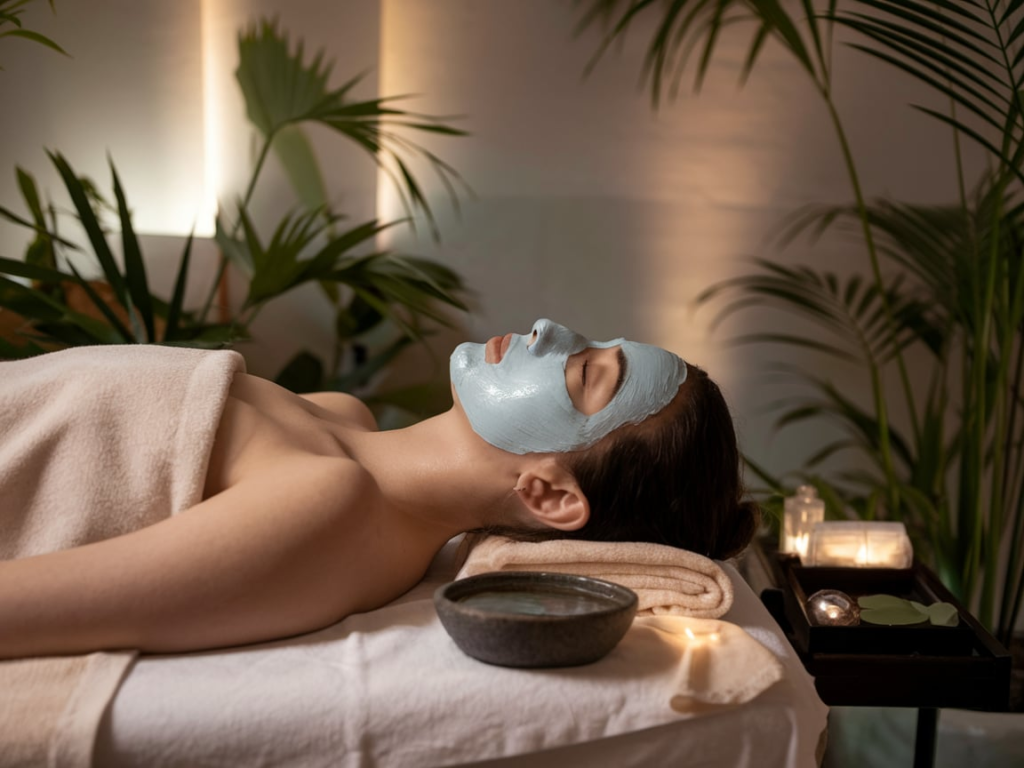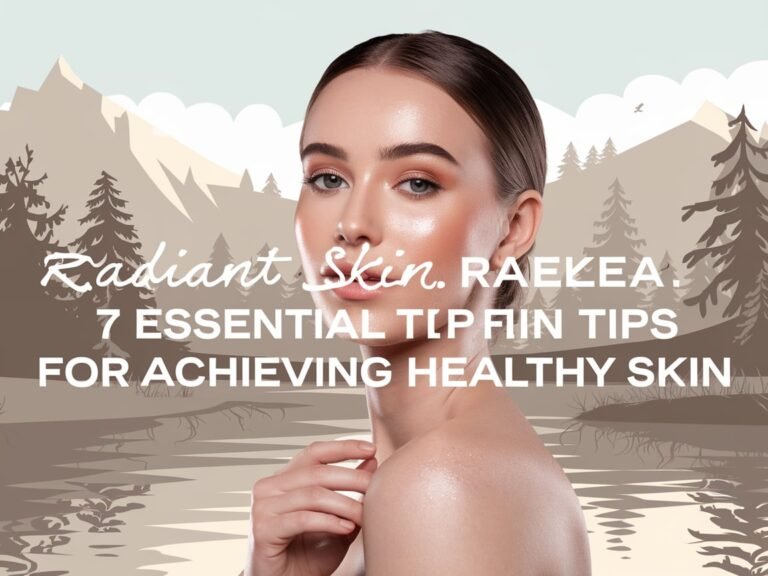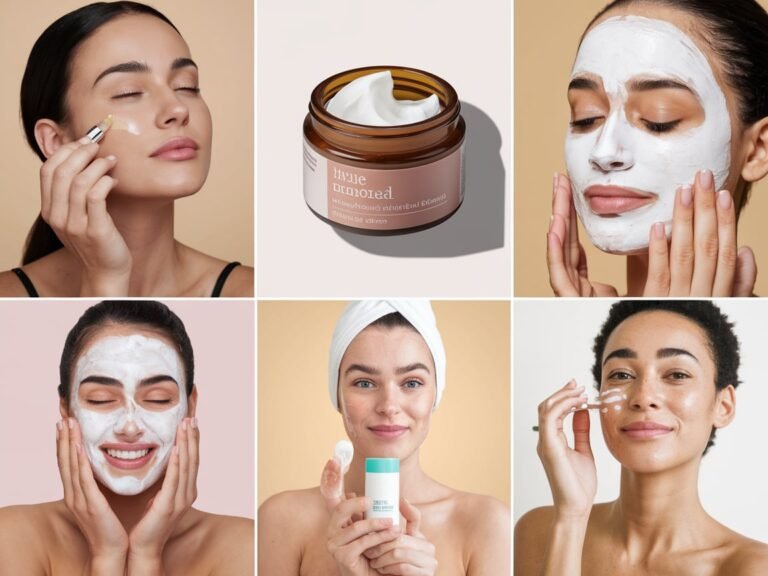
"Discover the path to healthy skin—because your beauty deserves the best!"
Achieving and maintaining healthy skin is a journey that requires dedication, knowledge, and a touch of self-love. While many products claim to offer miraculous results, the foundation of effective skin care lies in understanding your skin type, adopting a balanced routine, and making informed lifestyle choices. In this comprehensive guide, we will explore essential tips and practices to help you achieve glowing skin that radiates health and vitality.
Understanding Your Skin Type

Before diving into a skincare routine, it’s crucial to identify your skin type. The main categories include:
- Normal Skin: Balanced moisture and oil production. Pores are not too visible, and there are minimal blemishes.
- Dry Skin: Lacks moisture, leading to flakiness and tightness. May show signs of irritation or redness.
- Oily Skin: Excess sebum production results in shiny skin, enlarged pores, and a tendency to acne.
- Combination Skin: A mix of dry and oily areas, typically with an oily T-zone (forehead, nose, and chin) and dry cheeks.
- Sensitive Skin: Prone to redness, irritation, and reactions to products. Requires gentle care and specific formulations.
Tips for Identifying Your Skin Type
- Cleanse Your Face: Use a gentle cleanser to remove makeup and impurities, then leave your skin bare for a few hours.
- Observe Your Skin: After cleansing, notice how your skin feels. Is it tight, oily, or comfortable?
- Check Pore Visibility: Large pores may indicate oily skin, while minimal visibility suggests normal or dry skin.
For more detailed information on skin types, check out the American Academy of Dermatology.
Building a Skincare Routine

Once you understand your skin type, the next step is to establish a skincare routine tailored to your needs. A basic routine includes the following steps:
1. Cleansing
Cleansing is the cornerstone of any skincare routine. It removes dirt, oil, and impurities, allowing your skin to breathe and regenerate.
- Frequency: Cleanse twice daily—once in the morning and once before bed.
- Choose the Right Cleanser: Opt for a sulfate-free, pH-balanced cleanser that suits your skin type. Gel cleansers are great for oily skin, while cream or oil-based cleansers work well for dry skin.
For tips on choosing the right cleanser, visit the Mayo Clinic Skin Care.
2. Exfoliation
Exfoliating helps remove dead skin cells, promoting cell turnover and enhancing skin texture.
- Frequency: Exfoliate 1-3 times per week, depending on your skin type and sensitivity.
- Types of Exfoliants:
- Physical Exfoliants: Scrubs with granules (be cautious with these, as they can be abrasive).
- Chemical Exfoliants: AHA (alpha hydroxy acids) for dry skin and BHA (beta hydroxy acids) for oily skin are effective options.
3. Toning
Toners help restore your skin’s pH balance and prepare it for better absorption of subsequent products.
- Choose Alcohol-Free: Look for hydrating toners with ingredients like rose water, witch hazel, or aloe vera.
- Application: Use a cotton pad or your hands to apply toner after cleansing.
4. Serums
Serums are concentrated formulations packed with active ingredients that target specific skin concerns, such as hydration, pigmentation, and aging.
- Select Ingredients: Look for serums with hyaluronic acid for hydration, vitamin C for brightening, and retinol for anti-aging.
- Application: Apply a few drops to your fingertips and gently press them into your skin.
5. Moisturizing
Moisturizers help lock in hydration and protect your skin barrier.
- Choose the Right Formula: Gel-based moisturizers are ideal for oily skin, while cream-based moisturizers suit dry skin.
- Don’t Skip This Step: Even oily skin needs moisture to maintain balance.
6. Sun Protection
Sunscreen is essential for preventing skin damage and premature aging.
- Daily Use: Apply a broad-spectrum SPF 30 or higher every morning, even on cloudy days.
- Reapplication: Reapply every two hours, especially if you’re spending time outdoors.
For more information on the importance of sun protection, visit the Cleveland Clinic Skin Health.
Healthy Lifestyle Choices for Skin Care

While a good skincare routine is vital, your overall lifestyle plays a significant role in skin health. Here are some essential tips:
1. Hydration
Staying hydrated is key to maintaining skin elasticity and radiance.
- Drink Plenty of Water: Aim for at least eight 8-ounce glasses of water daily. Adjust based on your activity level and climate.
- Include Hydrating Foods: Foods like cucumbers, oranges, and watermelons can help with hydration.
2. Nutrition
What you eat directly impacts your skin’s appearance.
- Incorporate Antioxidants: Fruits and vegetables rich in vitamins A, C, and E help combat free radicals and promote healthy skin.
- Healthy Fats: Foods like avocados, nuts, and fatty fish provide essential fatty acids that support skin hydration.
3. Sleep
Adequate sleep is crucial for skin repair and regeneration.
- Aim for 7-9 Hours: Prioritize sleep by establishing a calming bedtime routine.
- Sleep on Your Back: This can prevent sleep lines and breakouts caused by friction with your pillowcase.
4. Stress Management
Chronic stress can exacerbate skin conditions like acne and eczema.
- Practice Mindfulness: Techniques such as meditation, yoga, or deep breathing can help manage stress levels.
- Engage in Hobbies: Pursuing activities you love can boost your mood and reduce stress.
5. Avoid Smoking and Limit Alcohol
Both smoking and excessive alcohol consumption can lead to premature aging and skin damage.
- Quit Smoking: Seek support if needed, as it can drastically improve your skin’s appearance.
- Limit Alcohol Intake: Alcohol can dehydrate the skin, so moderation is key.
Skin Care for Different Ages

Your skincare needs change over time. Here’s a quick overview of essential practices for different life stages:
In Your 20s
- Focus on Prevention: Use sunscreen daily to prevent sun damage and hyperpigmentation.
- Experiment with Products: This is a great time to explore different products and find what works best for you.
In Your 30s
- Add Anti-Aging Ingredients: Consider incorporating retinol and peptides to combat early signs of aging.
- Prioritize Hydration: Increase moisture levels, especially if your skin becomes drier.
In Your 40s and Beyond
- Reassess Your Routine: Your skin may require more nourishing products as it loses elasticity.
- Consult a Dermatologist: Consider professional treatments like chemical peels or laser therapy for targeted concerns.
Addressing Common Skin Concerns

Acne
Acne can be frustrating and may require a tailored approach.
- Gentle Cleansing: Use non-comedogenic products that won’t clog pores.
- Spot Treatments: Look for ingredients like benzoyl peroxide or salicylic acid.
Hyperpigmentation
Dark spots and uneven skin tone can be addressed with targeted treatments.
- Vitamin C Serums: These help brighten and even out skin tone.
- Sunscreen: Always apply sunscreen to prevent further darkening.
Dryness and Flakiness
Combat dry skin with rich moisturizers and hydrating serums.
- Avoid Hot Showers: Hot water can strip natural oils from your skin.
- Use a Humidifier: This can help maintain moisture levels in your environment.
Sensitivity and Redness
Sensitive skin requires gentle care.
- Fragrance-Free Products: Opt for products formulated for sensitive skin.
- Patch Testing: Always patch test new products to avoid adverse reactions.
Conclusion
Achieving and maintaining healthy skin is a multifaceted process that encompasses proper skincare routines, healthy lifestyle choices, and awareness of your skin’s unique needs. By understanding your skin type, following a tailored skincare regimen, and making informed lifestyle decisions, you can unlock the secret to radiant, healthy skin.
Remember, consistency is key, and results take time. Embrace the journey and treat your skin with the love and care it deserves. With patience and commitment, you’ll be well on your way to showcasing your most beautiful, glowing skin.
For more in-depth skin care resources, you can visit the Environmental Working Group (EWG) for product safety information.
“Your Skin Care Questions Answered: FAQs for Radiant Skin”

1. What is the best way to determine my skin type?
To determine your skin type, cleanse your face with a gentle cleanser and wait a few hours without applying any products. Observe how your skin feels: if it’s tight, you may have dry skin; if it’s shiny, you likely have oily skin; if it feels comfortable, you may have normal skin. Combination skin exhibits both dry and oily areas.
2. How often should I exfoliate my skin?
Exfoliation frequency depends on your skin type and sensitivity. Generally, it’s recommended to exfoliate 1-3 times per week. If you have sensitive skin, stick to once a week, while oily or thick skin may tolerate more frequent exfoliation.
3. Is sunscreen necessary even on cloudy days?
Yes, sunscreen is essential every day, regardless of the weather. Up to 80% of UV rays can penetrate clouds, leading to skin damage and increased risk of skin cancer. Use a broad-spectrum SPF of 30 or higher and reapply every two hours if you’re outdoors.
4. Can diet affect my skin’s appearance?
Absolutely! A balanced diet rich in antioxidants (like vitamins A, C, and E), healthy fats, and hydration can significantly impact your skin’s health. Foods like fruits, vegetables, nuts, and fatty fish can promote a radiant complexion.
5. How can I address common skin concerns like acne or dryness?
For acne, use non-comedogenic products, cleanse gently, and consider spot treatments with ingredients like benzoyl peroxide or salicylic acid. For dryness, opt for rich moisturizers and hydrating serums. Avoid hot showers and consider using a humidifier to maintain moisture in your environment.






